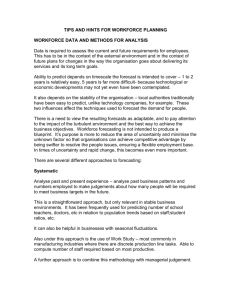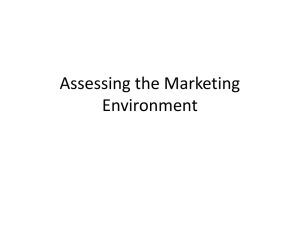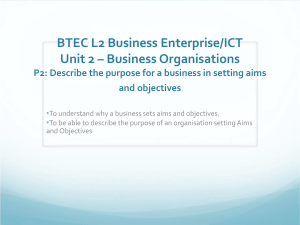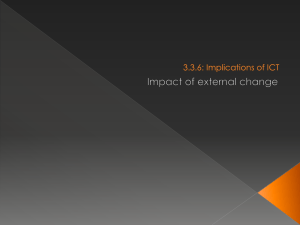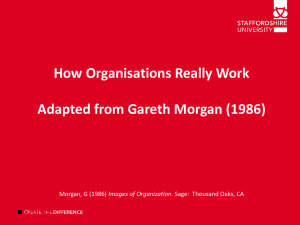HR Planning
advertisement
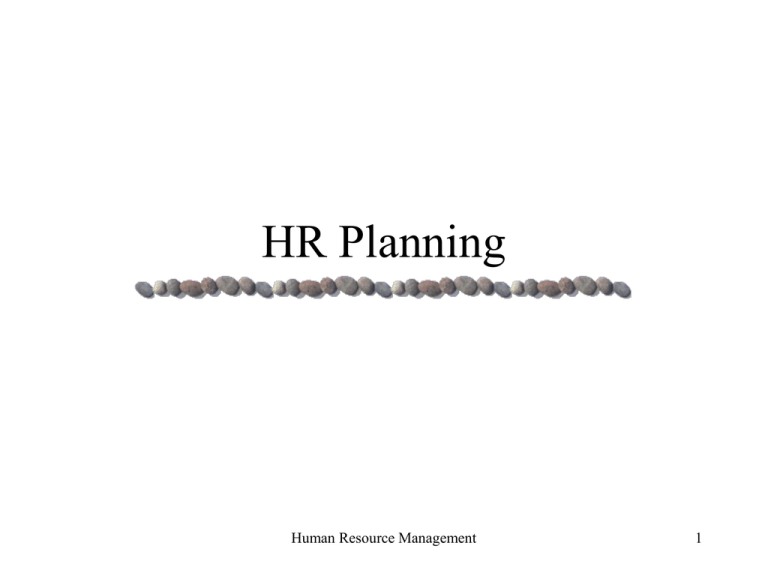
HR Planning Human Resource Management 1 HR Planning – Learning By the end of this unit you should be able to: 1. Define HR planning and explain its purpose 2. Describe the HR Planning process namely; Stocktaking, Forecasting, Planning and Implementing 3. Define and calculate labour turnover and explain its relevance to HR planning 4. Define and calculate absenteeism and explain its relevance to HR planning Human Resource Management 2 General Comments on HR Planning • • • • • • • Key aspect of HR Should link Business Strategy and HR Arguments for and against HRP Use of ‘computers’ Started in the 60’s as Manpower Planning Manpower Planning versus HR Planning HR Planning varies greatly across companies Human Resource Management 3 of HR Planning? “The process by which an organisation ensures that it has the right number and kinds of people, at the right place, at the right time, and capable of effectively & efficiently completing those tasks that will help the organisation achieve it’s overall strategic objectives” Human Resource Management, DeCenzo & Robbins, 1999 Forecasting the HR needs and planning the steps necessary to meet them Human Resource Management 4 Aims of HR Planning 1. Obtain & retain the quantity and quality of manpower needed 2. Make the best use of manpower resources 3. Anticipate potential surpluses/deficits Human Resource Management 5 Why is it important for an organisation to conduct HR Planning? 1. .. 2. .. 3. .. 4. .. Marchington & Wilkinson, Core Personnel & Development 2000 Human Resource Management 6 Benefits of HR Planning 1. Reduced costs 2. Improved planning of employee development 3. Improved business planning 4. Equality improvements 5. Promotion of HR planning 6. Useful tool for measuring HR success Human Resource Management 7 Human Resource Management, De Cenzo & Robbins1999 Human Resource Management 8 HR Planning Process 1. 2. 3. 4. Stocktaking / Analysing Forecasting Planning Implementation Human Resource Management 9 Human Resource Management 10 Personnel & HR Management, Gunnigle et al, 1997 Human Resource Management 11 Stocktaking – Internal; HR • Workforce profile (age, experience, skills, ability) • • • • • Age, experience, qualifications inventory Skills inventory Personnel replacement charts Training and development plans Performance reviews • Job analysis (what skills,knowledge, abilities are required) • Job descriptions • Skill audit Human Resource Management 12 Forecasting • Demand Forecasting – How many employees will be required for the future • Supply Forecasting – Where future employees are going to be found Human Resource Management 13 Demand Forecasting • INTERNAL – – – – – – organisational objectives operational plans product demand technology and administrative changes Capital investment plans Managerial judgement • EXTERNAL – economic climate, legislation, flexibility Human Resource Management 14 Supply Forecasting • • • • • • Classify manpower resources/Age analysis Labour turnover/Wastage analysis Promotions/Transfers Changes in hours/patterns of work Absence analysis Sources of supply Human Resource Management 15 Wastage analysis Measuring turnover number of employees who leave in one year average number employed in the past year x 100 Labour Stability Index number of employee’s with more than one years service x 100 total number employed one year ago Human Resource Management 16 Personnel & HR Management, Gunnigle et al, 1997 Human Resource Management 17 Personnel & HR Management, Gunnigle et al, 1997 Human Resource Management 18 How to calculate absenteeism Total absence (days/hours) in a particular period Total possible time (day/hours) Human Resource Management x 100 19 Exercise: Age Analysis 1. 2. 3. What do we mean by age analysis? Why would you conduct an age analysis? What are the following statements saying about age in the organisation – This organisation has a mature age profile – This organisation has a middle age profile – This organisation has a young age profile 4. List some advantages and disadvantages of each the above profiles? Human Resource Management 20 Sources of External Supply In establishing the sources of external labour supply one needs to be mindful of the following: • • • • • • Unemployment levels Employment trends Local market conditions Occupational market conditions Legislation e.g. equality, Social Partnership Human Resource Management 21 Sources of supply - Local • Level of unemployment • Open & closure of new workplaces • Nos. and qualifications of school and college leavers • Housing & transport developments • Employer reputation Human Resource Management 22 Exercise: Supply of labour local to organisations List factors that influence the supply of employees in the area LOCAL to an organisation? Human Resource Management 23 Stage 3: Planning By going through stages 1,2,3 an organisation establishes whether it is going to have a labour shortage or surplus. From this it will then need to PLAN how it is going to address this shortage or surplus. This is called the planning stage. Human Resource Management 24 Exercise: Planning List actions that an organisation can take if it identifies that it will have a labour SHORTAGE Human Resource Management 25 Exercise: Planning List actions that an organisation can take if it identifies that it will have a labour SURPLUS Human Resource Management 26 Stage 4: Implementation The implmentation stage involves • Putting the plan into action, setting the cycle set in motion • Monitoring, Reviewing, Altering and Evaluating that Plan regularly. Human Resource Management 27 But do organisations conduct HR Planning in Practice? • U.K.: Cowling & Waters(1990) – IPD survey, late ’80’s – Major uses of HRP were for • Identifying t&d needs • Analysing labour costs & productivity • Assessing need for structural change – HR Planning takes place on Ad hoc basis – Public Sector is behind the Private Sector • Kinnie & Arthurs (1993) – ¾ of organisations had computer systems, 1/3 using them for strategic purposes Marchington & Wilkinson, Core Personnel & Development 2000 Human Resource Management 28 HR Planning in Practice cont.. • U.S.A. Greer, Jackson & Fiorito (1989) – USA is not much better than the UK – 137 organisations in mid ’80’s – Qualitative techniques (such as replacement charts, personnel inventories, supervisor estimates)are more common than quantitative techniques – Major uses of HR planning include; career planning, hrd, affirmative action, avoiding shortages of key personnel • Huselid (1993) – Use of HR planning varies a great deal – Employers most likely to use HRP are large, r&d intensive orgs with sophisticated planning systems and HR managers who are actively involved at a strategic level Marchington & Wilkinson, Core Personnel & Development 2000 Human Resource Management 29 Why do so few organisations avoid HR planning? 1. Models & techniques not really rooted in the real world 2. Data is not held in user friendly form 3. The is no clear links between HR & Business plans 4. Senior Line Managers have little interest in or commitment to HR planning Marchington & Wilkinson, Core Personnel & Development 2000 Human Resource Management 30 Summary • HR Planning has a long way to go • HR Planning is not a substitute for managerial judgement but an aid to decision making • Changing nature of organisations is going to influence HR Planning Human Resource Management 31 Extra Reading – all in Moodle! • • • • Chapter 5 (pg 92 – 103) in core text book CIPD Factsheet: Absence Management CIPD Factsheet: Employee Turnover Crown Hotel HR Planning Exercise Human Resource Management 32 Sample exam questions 1. Describe the four stages in the HR planning process. 2. Describe 3 actions you could take to fill a labour shortage in a company? 3. Describe 3 actions you could take to resolve a labour surplus in a company? 4. Why is it important to know what the organisation mission and objectives are before you commence HR planning? 5. Explain the term labour turnover. Discuss the reasons why employees leave organisations. Discuss the actions organisations can take to improve employee retention. 6. According to the CIPD (2004) employee turnover is much higher in retailing, hotels & restaurants & call centres than among civil servants, fire fighter and the police. Discuss at least three reasons why this is so and describe at least 5 actions that organisations with unacceptably high turnover may take to reduce attrition rates 7. Imagine that you have just been given the task of devising a human resource plan for Next clothing retail in Sligo. What information would you need in order to put this plan together. Human Resource Management 33

